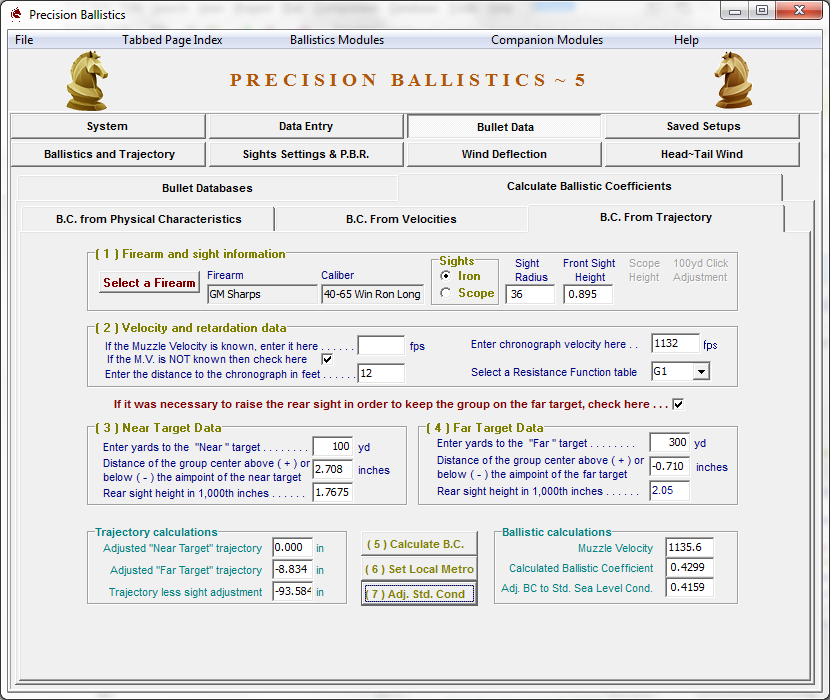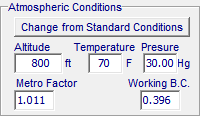
Contents - Index - Previous - Next
Estimate a Ballistic Coefficient from a Trajectory
Providing that careful, precise measurements are made of muzzle velocity, range distance and target group centers, calculating values from a trajectory is an excellent method of acquiring a useful, reliable ballistic coefficient. The rifle needs to be relatively accurate and capable of producing repeatable group sizes. The group centers should be calculated to within at least 0.01" from the aiming points and if sight adjustments are made to keep the groups on target, these adjustments must be measured to within 0.001" .
If sight adjustment is needed, the distance in inches from the front sight to the rear sight along with the height of the front sight should be recorded. If a telescope sight is used, targets large enough to keep the groups on paper should be used as telescope sights are not noted as having predictable, repeatable adjustment increments. Although if need be, scope adjustments may be translated into mechanical sight adjustments as described below.
In order that an accurate muzzle velocity may be determined, a chronograph should be used to record the average velocity through the screens .The distance from the muzzle to the center of the chronograph screens should be carefully measured.
If it is observed that one sight setting can be used and still maintain both of the target groups on a target face, the rear sight height need not be measured and recorded. Otherwise determine a method to record the rear sight height to 0.001" .
First, determine the longest range that can be fired and still maintain reasonable accuracy then carefully measure the distance in yards from the muzzle to the target. It need not be and even number of yards, just an accurate measurement. Record that distance as the "Far Target" range.
Next, choose a range somewhere between 1/3 and 2/3 the distance to the Far Target. Carefully measure this distance from the muzzle and record the range as the "Near Target" range.
Then, set up a chronograph and measure the distance from the center of the screens to the muzzle in feet.
Now, fire as many shots as needed (at least 10) to produce as good a group as is possible on the near target. (the group center need not be precisely on the point of aim) Shoot through the chronograph and record the velocities. Throw out any fliers as they contribute nothing to a calculation of the ballistic coefficient.
Finally, If the rear sight needs to be elevated to get the group on the Far Target, make the adjustment and record the sight movement to 0.001" then proceed to fire enough shots to produce a good group on the Far Target, again throwing out any fliers, and recording the velocities of the shots.
If a telescope sight is in use and needs to be adjusted to keep the group on the far target, then multiply the number of clicks by the amount of movement produced at 100 yards per click, then divide that product by 100. Enter the resulting value in the Far target sight adjustment window, enter a value of "36" in the Sight Radius window, ensure that the 'Scope Height value is correctly entered and then proceed as if a mechanical sight was used.
Retrieve the targets and carefully measure the distance of each shot above or below the aim point and then add the values and divide by the number of shots scored to produce the average distance of the group center above or below the aim point. Make these measurements to 0.01", or better yet, to 0.001".
Now there are enough values to go to the software and calculate a ballistic coefficient.
The images below will show the values of an actual test of a 426 grain, 40 cal., Bore Ride, Round Nose Bullet cast from an NEI mold.
Near Target distance = 100 yards,
Far Target distance = 300 yards
Near Target group center averaged 2.708" above the aim point.
Near Target vernier sight cup was 1.7675" above the tang
Far Target group center = -0.710" below the aim point
Far Target sight setting was 2.050" above the tang
The Pedersoli Sharps has a sight radius of 36" and a front sight height of 0.90"
The Muzzel Velocity of the load was not known.
Average Chronograph readings for all shots on both targets was 1132 f.p.s.
Distance to chronograph screens was 12 feet.

The muzzle velocity is calculated at 1135.6 f.p.s.
The ballistic coefficient is calculated at 0.4299

Finally, the local atmospheric conditions are factored and the Adjusted Sea Level Ballistics Coefficient is 0.4159
Copyright 2002-2017. TMT Enterprises. All rights reserved.